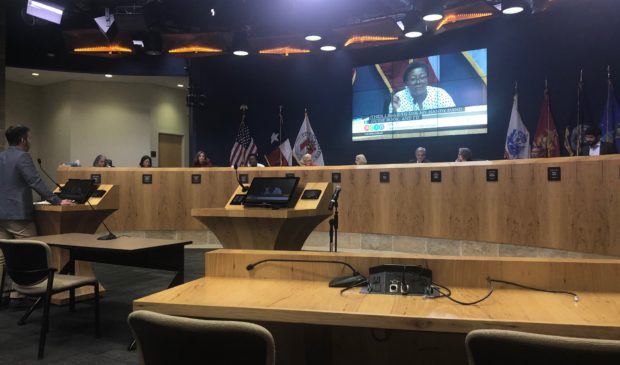Newsletter Signup
The Austin Monitor thanks its sponsors. Become one.
Most Popular Stories
- Latest State of Downtown report shows the city core’s businesses and housing are in transition
- Cap Metro to shelve 46 new electric buses for a year after manufacturer bankruptcy
- Jesús Garza disputes allegation that he violated city ethics rule
- Mobility Committee hears public concern regarding expansion of MoPac
- Council gives first reading OK to major development on tiny slice of land
-
Discover News By District
Popular Whispers

Development code vote kicked down the road
Friday, April 26, 2019 by Ryan Thornton
City staffers are not quite in the clear to officially start work drafting a new Land Development Code. City Council was preparing to make a vote this week that would provide direction to City Manager Spencer Cronk regarding the code, but that vote had still not come up by the time Council adjourned its meeting at 11:30 p.m. on Thursday.
Despite members’ inexhaustible tendency to plunge into the details of the city’s housing and transportation policies, Council managed to keep a bird’s-eye view long enough to approve a preliminary document of responses to the five questions in Cronk’s memo regarding the new code. (Cronk’s memo addressed housing types and capacity, parking and standards regulating what types of buildings can be built in proximity to one another.)
With the specter of the $8.5 million, six-year ghost of CodeNEXT still looming, some on the dais – particularly Council members Natasha Harper-Madison and Jimmy Flannigan – had been hoping to leave both its policies and its ideological baggage in the rearview. Wanting to do this as efficiently as possible, Mayor Steve Adler has led Council toward a compromise that will allow Draft 3 to serve city staff as a foundation for a new code while fully recognizing its limitations.
But the drama of CodeNEXT is proving unwilling to rest in peace. Mayor Pro Tem Delia Garza mourned the short period of civility she said ended with a flurry of emails to her inbox Wednesday night following an alarmist email sent out to the community by Council Member Leslie Pool. Pool’s email cited concern that Council was preparing to send city staff on a code rewrite mission that could weaken impervious cover requirements, eliminate ADA-compliant parking spaces at certain sites and threaten the city’s fragile safeguards against flooding.
On Thursday, Garza urged her fellow city leaders to be responsible with the information they send to constituents. Garza echoed her earlier social media response to Pool’s email in which she denounced the use of “Trump-esque scare tactics” and clarified Council’s agreement that a necessary aim of the new code should be to reduce overall impervious cover across the city and address the city’s vulnerability to flooding.
As a whole, Council wants to push beyond the proposals of Draft 3, growing far more capacity for “missing middle” housing types (from duplexes to small apartment buildings), going further to reduce parking minimums and decreasing the impact of compatibility standards to a greater extent than Draft 3 had outlined.
Regarding the preservation of unique zoning overlays and special districts, Council is asking staff to avoid eliminating them entirely as Draft 3 had proposed, preferring instead to consider carrying them over into the new code while leaving them open to additional zoning overlays.
Under this compromise, a Neighborhood Conservation Combining District, for example, would be allowed to keep certain characteristic restrictions (like prohibiting privacy fences in the front yard, in the example of Hyde Park) while still being subject to any broadly applied zoning changes.
One of those sweeping changes being considered would allow for a certain number of units per lot (three or four) across much of the urban core. Council members Kathie Tovo and Alison Alter are hoping to put the cap on such by-right entitlements at three units per lot while a majority of Council members appear more comfortable with at least four.
Alter reiterated concern that simply allowing developers to build multiple units on a lot would be a lost opportunity to take full advantage of the city’s density bonus program, which requires inclusion of income-restricted units or affordable housing fees for developers wishing to exceed current zoning limits.
Harper-Madison expressed concern about the economic viability of expecting developers of smaller missing-middle housing types to provide affordable units or pay additional fees.
Council Member Greg Casar proposed new language allowing staff to consider housing type and location before specifying when a density bonus program would be a useful mechanism to achieve more housing units without pushing developers away.
City staffers are also being given authority to decide when, due to lack of sidewalks or limited space, it might not be a good idea to eliminate parking requirements in areas within a quarter-mile of activity centers and corridors. If conditions permit, however, and excepting ADA-compliant spaces, Council has given staff direction to explore eliminating parking mandates in those high-activity areas.
With an initial document of responses to Cronk’s questions in place, Council will be bringing the issue back to take up unresolved amendments and take a vote in a special session next week.
Photo by Ryan Thornton.
The Austin Monitor’s work is made possible by donations from the community. Though our reporting covers donors from time to time, we are careful to keep business and editorial efforts separate while maintaining transparency. A complete list of donors is available here, and our code of ethics is explained here.
You're a community leader
And we’re honored you look to us for serious, in-depth news. You know a strong community needs local and dedicated watchdog reporting. We’re here for you and that won’t change. Now will you take the powerful next step and support our nonprofit news organization?








